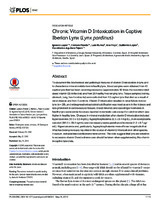| dc.contributor.author | López, Ignacio | |
| dc.contributor.author | Pineda Martos, Carmen María | |
| dc.contributor.author | Muñoz, Luis | |
| dc.contributor.author | Raya, Ana I. | |
| dc.contributor.author | López, Guillermo | |
| dc.contributor.author | Aguilera Tejero, Escolástico | |
| dc.date.accessioned | 2018-12-07T11:29:15Z | |
| dc.date.available | 2018-12-07T11:29:15Z | |
| dc.date.issued | 2016 | |
| dc.identifier.uri | http://hdl.handle.net/10396/17561 | |
| dc.description.abstract | To document the biochemical and pathologic features of vitamin D intoxication in lynx and
to characterize mineral metabolism in healthy lynx, blood samples were obtained from 40
captive lynx that had been receiving excessive (approximately 30 times the recommended
dose) vitamin D3 in the diet, and from 29 healthy free ranging lynx. Tissue samples (kidney,
stomach, lung, heart and aorta) were collected from 13 captive lynx that died as a result of
renal disease and from 3 controls. Vitamin D intoxication resulted in renal failure in most
lynx (n = 28), and widespread extraskeletal calcification was most severe in the kidneys and
less prominent in cardiovascular tissues. Blood minerals and calciotropic hormones in
healthy lynx were similar to values reported in domestic cats except for calcitriol which was
higher in healthy lynx. Changes in mineral metabolism after vitamin D intoxication included
hypercalcemia (12.0 ± 0.3 mg/dL), hyperphosphatemia (6.3 ± 0.4 mg/dL), increased plasma
calcidiol (381.5 ± 28.2 ng/mL) and decreased plasma parathyroid hormone (1.2 ± 0.7 pg/
mL). Hypercalcemia and, particularly, hyperphosphatemia were of lower magnitude that
what has been previously reported in the course of vitamin D intoxication in other species.
However, extraskeletal calcifications were severe. The data suggest that lynx are sensitive
to excessive vitamin D and extreme care should be taken when supplementing this vitamin
in captive lynx diets. | es_ES |
| dc.format.mimetype | application/pdf | es_ES |
| dc.language.iso | eng | es_ES |
| dc.publisher | Public Library of Science | es_ES |
| dc.rights | https://creativecommons.org/licenses/by-nc-nd/4.0/ | es_ES |
| dc.source | PLoS ONE 11(5): e0156331 (2016) | es_ES |
| dc.subject | Lynx | es_ES |
| dc.subject | Hypervitaminosis D | es_ES |
| dc.subject | Vitamin D intoxication | es_ES |
| dc.title | Chronic Vitamin D Intoxication in Captive Iberian Lynx (Lynx pardinus) | es_ES |
| dc.type | info:eu-repo/semantics/article | es_ES |
| dc.relation.publisherversion | http://dx.doi.org/10.1371/journal. pone.0156331 | es_ES |
| dc.relation.projectID | Gobierno de España. LIFE06NAT/E/000209 | es_ES |
| dc.relation.projectID | Junta de Andalucía. CTS-179 | es_ES |
| dc.rights.accessRights | info:eu-repo/semantics/openAccess | es_ES |

